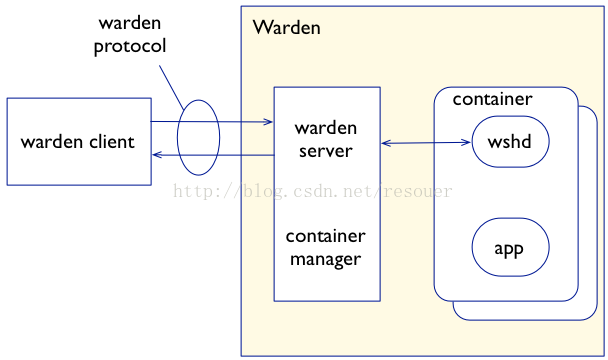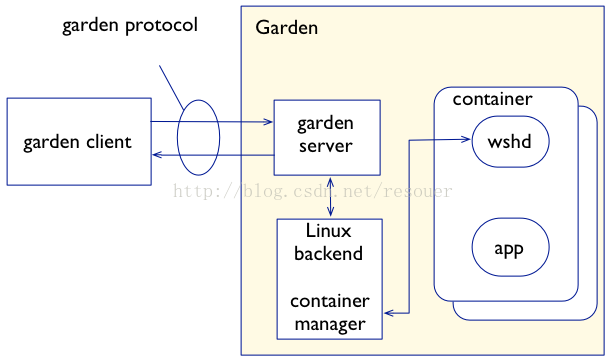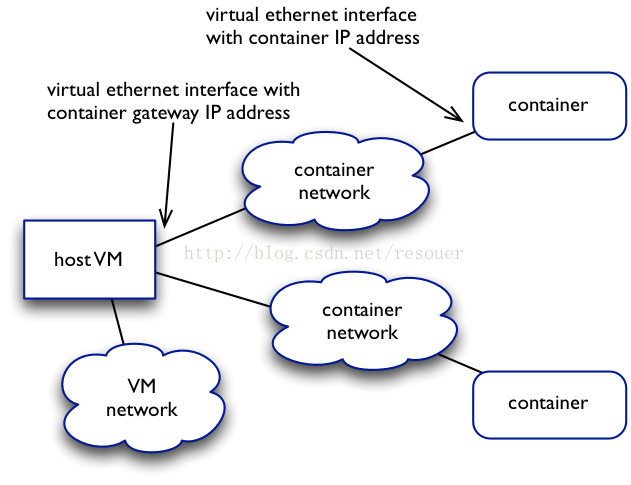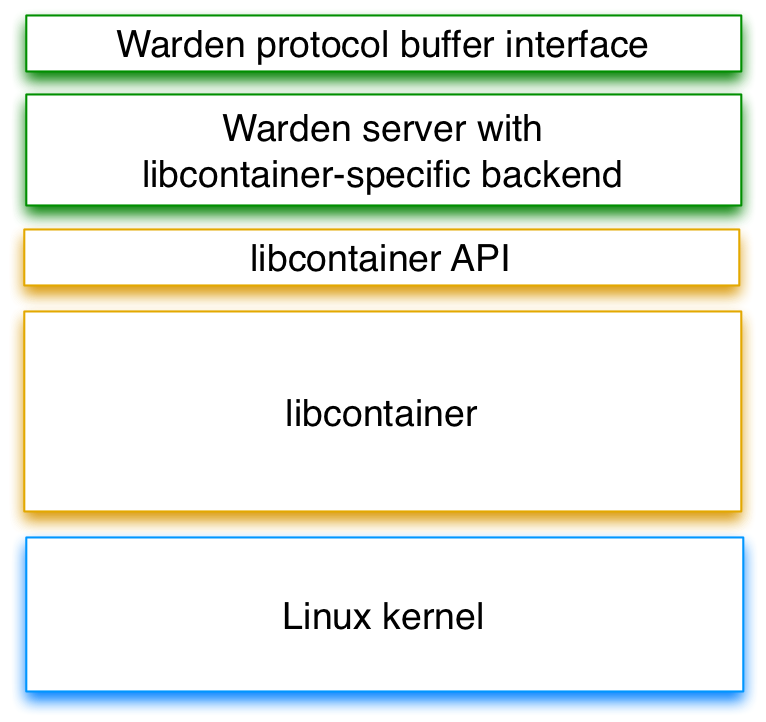丁轶群 | 2014-12-02
前言
编译自:
Cloud Foundry’s Container Technology: A Garden Overview
Containers in Cloud Foundry: warden meets libcontainer
CloudFoundry(CF)中很早就使用了VMware研发的Warden容器来负责应用的资源分配隔离和实例调度。可惜的是,这一本来可以成为业界标准和并掀起一阵革命的容器PaaS技术却因为Pivotal的方针路线上的种种原因被后来居上Docker吊打至今。最近CFer有醒悟的迹象,在Warden上进行了大量改进和升级,本文就来一窥CF新容器技术的一些要点。
Warden和Garden
Warden背景:
“CloudFoundry’s container technology is provided by Warden,which was created by VMware’s Pieter Noorduis and others.Warden is a subtle combination of Ruby code, a core written inC, and shell scripts to configure the host and containers.”
在此前的WardenDEA中,在每个安装好的DEA上都会运行Warden服务(Ruby写的,调用大量shell来配置host),用来管理Cgroup,Namespaces和以及进程管理。同时,Warden容器的感知和状态监控也由此服务来负责。作为一个C/S结构的服务,Warden使用了谷歌的protobuf协议来负责交互。每个容器内部都运行一个wshd daemon(C语言写的)来负责容器内的管理比如启动应用进程,输出日志和错误等等。这里需要注意的正是由于使用了protobuf,warden对外的交互部分强依赖于wardenprotocol,使得warden对开发者的易用性大打折扣。

Wardenstructure
在CloudFoundry的下一代PaaS项目Diego中,Pivotal团队对于Warden进行了基于Golang的重构,并建立了一个独立的项目Garden。在Garden中,容器管理的功能被从server代码里分离出来,即server部分只负责接收协议请求,而原先的容器管理则交给backend组件,包括将接收到的请求映射成为Linux(假如是Linux backend的话)操作。值得注意的是:这样backend架构再次透露出了warden跨平台的野心,可以想象一旦Windowsbackend被社区(比如IronFoundry)贡献出来后的威力。更重要的是,RESTful风格的API终于被引入到了Garden里面,原作者说是为了实验和测试,但实际上Docker最成功的一点正是友好的API和以此为基础的扩展能力。

Gardenstructure
Namespaces
容器化应用依然通过namespaces来定义它所能使用的资源。最简单的例子,应用的运行需要监听指定的端口,而传统方法中这个端口就必须在全局的host网络namespaces上可见。为了避免应用互相之间出现端口冲突,Garden服务就需要设置一组namepaces来隔离每个应用的IP和port(即网络namespace)。需要再次强调,容器化的应用资源隔离不同于传统的虚拟化技术,虽然我们在讲容器,但是我们并没有去创建“什么”,而是为实实在在运行着的应用进程划分属于它自己的“命名空间”。 Garden使用了除用户namespace之外的所有namespace技术。具体实现是使用挂载namespace的方法来用用户目录替换原host的root文件系统(使用pivot_root指令),然后unmount这个root文件系统使得从容器不会直接访问到该目录 备注:Linux在很早之前就支持了namespaces技术,从一开始为文件系统挂载点划分namespace,到最新的为用户添加namespace,具体演化参见:Articles on Linux namespaces
ResourceControl
被限制在运行在namespaces中的应用可以在这个“匿名的操作系统环境“中自由的使用类似于CPU和MEM这样的资源,但是应用仍然是直接访问系统设备的。Linux提供了一系列controlgroups来将进程划分为层级结构的组然后将它们限制到不同的约束中。这些约束由cgroup中的resourcecontrollers来实现并负责与kernel子系统进行交互。举个例子:memoryresource controller可以限制一个controlgroup中的进程能够在真实内存中使用的页数,从而确保这些进程在超出限制后被停止。 Garden使用了五种资源控制:cpuset(CPUs and memory nodes) , cpu (CPU bandwidth), cpuacct (CPUaccounting), devices (device access), and memory(memoryusage),并通过这些资源控制堆每一个容器设置一个controlgroup。所以容器中的进程将被限制在resourcecontrollers指定的资源数下运行(严格地说cpuacct仅统计CPUusage,并不做出具体限制)。 此外,Garden还使用setrlimit系统调用来控制容器中进程的资源使用;使用setquota来为容器中的用户设置配额。这一点上也同Warden相同。
NetworkingFacilities
简单来说,每个容器都运行在独立的网络namespace中,Garden负责控制进出容器的网络流量。Garden会创建一对veth(虚拟网卡)设备,为它们分配IP,然后将其中的一个放到容器的网络namespace中。接下来Garden会设置IP路由表来保证IP包能够正确地传入或传出容器。最后,网络包过滤规则会为容器创建防火墙来限制inbound和outbound的流量。这一点上与Warden原先的网络相同。

Containernetworking
RootFile System
Warden是允许用户自己指定一个root文件系统来供容器使用的。而Garden不仅继承了这个功能,更重要的是还能支持从Docker image来构建rootfs。同时,Garden在rootfs中引入了rw权限的层,所以容器可以叠加自己的rootfs而不影响其他容器(比如container A是warden rootfs,而container B是docker rootfs)
GardenAPI
新的Garden API同样是基于Google protobuf的,包括如下所有操作:
- Capacity– returns the memory and disk capacity of the host machine
- Create– creates a container and returns its handle (a string which identifies the container)
- Info –returns information about a specified container such as its IPaddress and a list of processes running in the container
- Run –spawns a process in the container and streams its output back to theclient
- Attach– starts streaming the output of a specified process ina specified container back to the client
- List –lists all container handles
- LimitBandwidth,LimitCpu, LimitDisk, LimitMemory – adjusts the limits of aspecified container for network bandwidth, CPU shares,disk usage, and memory usage, respectively
- NetIn –maps a port on the host machine to a port in the specified container
- NetOut– whitelists outbound network traffic from the specified containerto a specified network and/or port
- StreamIn– copies data into a specified file in the specifiedcontainer’s file system
- StreamOut– copies data out of a specified file in the specifiedcontainer’s file system
- Ping –checks that the garden server is running
- Stop –terminates all processes in a specified container but leaves thecontainer around (instopped state)
- Destroy– destroys the specified container
Merge Warden with Docker?
与此同时,Pivotal还计划通过更通用的驱动层来将Docker直接merge到现有的系统中。主要实现方式是为前面所说的backend添加libcontainer-specific backend,如下图所示:

这样,用户的请求将通过这个backend翻译成libcontainer API来启动Docker镜像——比如将用户的应用run在Docker而不是Warden容器中。但是这个feature是作为一个长期计划与Garden并行的,主要原因应该是libcontainer的API并没有完全ready,目前还在采用很初级的替代方案。 综上,CF的新容器技术向后来者Docker展示了友好的一面,并且把握住了Docker image这一核心value而不是费力不讨好地支持所有Docker feature。但是这此的改动还是一次被动的应对,恐怕只有Windows backend和libcontainer backend的及时release才能迅速扭转局面。
